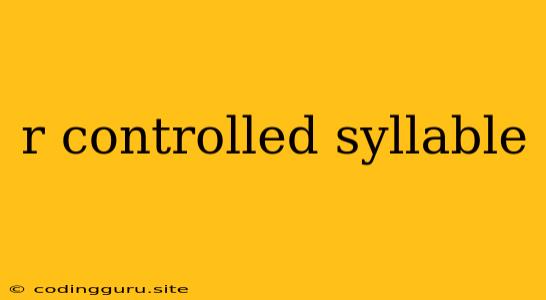R-Controlled Syllables: Unveiling the Secrets of the "R" Sound
Have you ever wondered why words like "bird" and "fur" don't sound like "bid" and "fuh"? The answer lies in the fascinating world of r-controlled syllables.
In simple terms, an r-controlled syllable occurs when the letter "r" follows a vowel within a syllable. This seemingly simple arrangement significantly alters the vowel's sound, creating a distinct "r" sound that's unique to these syllables.
Understanding the "R" Influence
Think of the "r" as a sneaky little letter that changes the way the vowel is pronounced. It doesn't just sit there quietly; it takes control, giving the vowel a new identity.
Let's look at some examples:
- "car": The vowel "a" is no longer a short "a" sound like in "cat." The "r" steps in and creates the "ar" sound.
- "bird": The vowel "i" doesn't sound like the long "i" in "bike." The "r" transforms it into the "er" sound.
- "fur": The vowel "u" doesn't sound like the "u" in "cup." The "r" changes it into the "ur" sound.
R-Controlled Vowel Sounds
These vowel sounds are unique to r-controlled syllables. Here's a breakdown:
- ar: Like in "car," "star," "far," "hard"
- er: Like in "bird," "her," "term," "fern"
- ir: Like in "girl," "shirt," "stir," "first"
- or: Like in "for," "door," "horse," "north"
- ur: Like in "fur," "turn," "burn," "nurse"
Common Misconceptions
It's easy to be confused about r-controlled syllables when learning to read and spell.
Myth: The "r" is always pronounced like the "r" in "run" or "red."
Truth: The "r" sound in r-controlled syllables is a unique sound, not the same as the standard "r" sound.
Myth: The "r" is always silent in these syllables.
Truth: The "r" isn't exactly silent, but it influences the vowel sound, producing the characteristic "r" sound within the syllable.
Tips for Mastering R-Controlled Syllables
- Practice, practice, practice!: The more you encounter r-controlled syllables in reading and writing, the better your understanding will become.
- Use flashcards: Create flashcards with words containing r-controlled syllables to test yourself on the sounds.
- Listen carefully: Pay close attention to how words with r-controlled syllables are pronounced in spoken language.
- Remember the vowel sounds: Memorize the unique sounds created by each vowel in r-controlled syllables.
R-Controlled Syllables in Action:
Here are some examples of r-controlled syllables in action:
- "The little girl had a red shirt.": Notice the r-controlled syllables in "girl," "shirt," and "red."
- "The farmer's horse is strong and fast.": Observe the r-controlled syllables in "farmer," "horse," and "strong."
- "The birds sing a beautiful song.": Focus on the r-controlled syllables in "birds" and "song."
Conclusion
R-controlled syllables are a crucial part of the English language. By understanding their unique characteristics, you'll become a more confident reader and writer. So, next time you encounter a word like "bird" or "fur," remember the power of the "r" and how it shapes the sound of the vowel.
